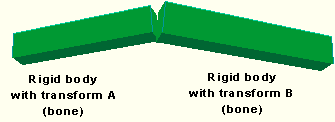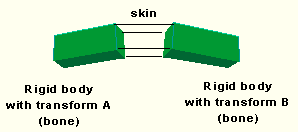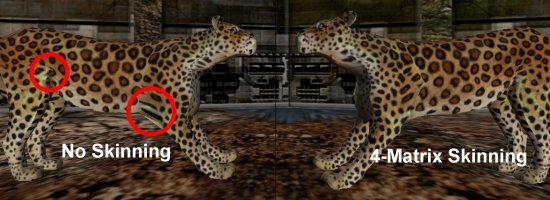ATi's New Radeon - Smart Technology Meets Brute Force
Vertex Skinning
This new term is an enhancement of what NVIDIA calls 'vertex blending'. As you know, lately characters in games, such as animals, monsters or players, are animated using a technique that is called 'skeletal animation'. The idea is to define 'bones' in limbs and attach the surrounding tissue in form of vertices around this 'bone'. The behavior of these 'tissue vertices' will then depend on the bones that were defined to influence their appearance. The thought behind this animation technique is to save storage space, loading times and system memory, because it keeps a game from having to provide all the different appearances of the limbs for a movement. Instead, those different appearances are computed, depending on the position of the 'bones'.
The problem with skeletal animation is that it creates gaps when the joint between two bones is bent too far.
With 'Vertex Skinning' or 'Vertex blending' this problem can be solved. The usual 2-matrix vertex blending/skinning, as used by NVIDIA's GeForce chips, joins the two bones together, to create a more or less realistic joint.
ATi's Radeon supports a more sophisticated version of vertex skinning or blending than NVIDIA's GeForce group of chips. It's called '4-Matrix Skinning'. In skeletal animation a bent joint requires different matrix transformations for the vertices of the 'tissue' around each 'bone'. While the transformation of each added matrix requires a lot of computation power, a joint looks more realistic the more 'bones' and thus matrices are used. The knee joint would be a typical example, where the patella (knee cap) would add another 'bone' and thus matrix to make the knee joint look realistic. NVIDIA's GeForce chips can do this transformation of more than two matrices only in software, which requires a lot of CPU power. Radeon is able to transform up to four matrices in hardware, thus offering a more realistic way of skeletal animation without performance penalty.
Keyframe Interpolation
This funky feature is also known under the name 'morphing' out of the 2D-world. It comes into play where skeletal animation doesn't work. The changing expression on a face even if the character is only speaking and thus opening and closing his mouth as well as bulging muscles can be animated with this technique in a rather easy fashion. The idea is simple. You simply need two conditions, as e.g. a face that's frowning and smiling. Then you use those two frames as 'keyframes' and interpolate a few frames in between, to 'morph' the face from the one expression to the other.
This way game characters can be shown a whole lot more life-like. They can talk and show facial expressions. Several game developers have already decided to use this feature in their next games.
Summarizing Radeon's T&L Features
It is pretty obvious that Radeon's T&L shines over the one of NVIDIA's GeForce2 GTS. If ATi's claims are correct then Radeon is able to apply T&L to more polygons per second than GeForce2 GTS, but Radeon throws in 4-matrix vertex skinning and keyframe interpolation as well. From that point of view the standing is 1:0 for Radeon.
Get Tom's Hardware's best news and in-depth reviews, straight to your inbox.
Current page: Vertex Skinning
Prev Page Hardware T&L, Continued Next Page Excurse - The Next Step Of The 3D Pipeline After T&L, The Triangle Setup


